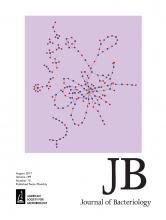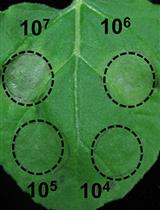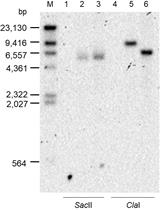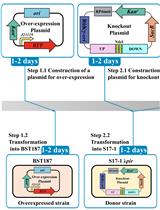- EN - English
- CN - 中文
Quantitative Transformation Efficiency Assay for Bacillus subtilis
枯草芽孢杆菌转化效率的定量测定
发布: 2018年12月05日第8卷第23期 DOI: 10.21769/BioProtoc.3109 浏览次数: 8846
评审: Modesto Redrejo-RodriguezMelanie BerkmanAnna McLoon
Abstract
Bacillus subtilis (B. subtilis) is a model Gram-positive organism used to study a variety of physiological states and stress responses, one of which is the development of competence. Competence refers to the physiological state of a cell which allows it to be transformed naturally. Through induction of competence, the efficiency of natural transformation can be quantified by plating colony forming units (CFU) and transforming units (TFU). Here we describe a protocol for quantifying relative transformability using B. subtilis.
Keywords: Natural transformation (自然转化)Background
Natural transformation is a type of horizontal gene transfer that involves a bacterium importing exogenous DNA from the environment and recombining that DNA into its genome. This process differs from induced transformation in that naturally transformable bacteria produce proteins that facilitate the import of DNA. Modification of the cell membrane, such as through electroporation or heat shock, is typically essential for induced transformation. Natural transformation can lead to the acquisition of new genetic elements, such as antibiotic resistance or catabolic genes, and may allow bacteria to adapt rapidly to their environment. The various proteins involved with the development of competence, or the physiological state of a cell which allows it to be transformed naturally, and the mechanism of natural transformation are not yet fully understood. Quantitative analysis of transformation efficiency differences between a mutant and wild type provides insight into the contribution and potential functions of the gene in question. Beginning with the description of requirements for transformation of laboratory strains of Bacillus subtilis by Anagnostopoulos and Spizizen (1961), numerous variations on the original media and conditions for transformation, both qualitative and quantitative methods, have been described including but not limited to those by Dubnau and Davidoff-Abelson (1971) and Cutting and Vander Horn (1990). The experimental procedure described here is similar to those prior, focusing on currently available and preferred materials (such as casein hydrolysate, which has been found to produce varying efficiencies based on lot and manufacturer), and includes description of statistical analysis of the results.
Materials and Reagents
- Sterile pipette tips
- Sterile 18 mm glass tubes (Fisher Scientific, catalog number: S63300)
- Sterile 13 mm glass tubes (Fisher Scientific, catalog number: 14-961-27)
- Sterile stainless steel closures (18 mm neck size) (VWR, catalog number: 71000-330)
- Sterile stainless steel closures (13 mm neck size) (VWR, catalog number: 71000-322)
- Sterile 1.7 ml microfuge tubes (Denville Scientific, catalog number: C2170)
- Sterile 60 ml Luer Lock syringes (Fisher Scientific)
- Sterile Acrodisc® 13 mm syringe filters (0.2 µm pore size) (VWR, catalog number: 28142-340)
- Sterile syringe filter disc (0.2 µm pore size) (VWR, catalog number: 28145-477)
- 1.5 ml Cuvettes (Dot Scientific, catalog number: 2410)
- Aluminum foil
- 100 x 15 mm Petri dishes (Crystalgen, catalog number: S-3006)
- Sterile glass beads (diameter 0.2-0.3 mm) (Sigma-Aldrich, catalog number: G1277)
- Sterile streaking sticks (flat toothpicks) (VWR, catalog number: 500029-808)
- Bacillus subtilis (B. subtilis)
Note: This includes the control strains and tested strains. For control strains, B. subtilis subsp. subtilis str. 168 or B. subtilis str. PY79 are typically used. - LB broth (Sigma-Aldrich, catalog number: L3022-1KG)
- LB agar (VWR, DifcoTM, catalog number: 90003-346)
- NaCl (Dot Scientific Inc., catalog number: 7647-14-5)
- KCl (RPI, catalog number: P41025-500.0)
- Na2HPO4 (J.T. Baker, catalog number: 7558-79-4)
- KH2PO4 (VWR, catalog number: 7778-77-0)
- NaOH (Sigma-Aldrich, catalog number: 221465-500G)
- K2HPO4 (Dot Scientific Inc., catalog number: DSP41300-1000)
- Glucose (Amresco Inc., catalog number: 50-99-7)
- Sodium citrate dihydrate (Na3C6O7•2H2O) (VWR, SX00445-1 EMD)
- Casein hydrolysate (EMD, catalog number: 1.02245.0500)
- Potassium glutamate monohydrate (Sigma-Aldrich, catalog number: G1501-100G)
- 100 ng/µl genomic DNA with selectable marker
Note: The marker on the donor DNA should not be present in any of the strains being tested. - MgSO4 (Sigma-Aldrich, catalog number: M7506)
- Ammonium iron citrate (J.T. Baker, catalog number: 1185-57-5)
- Antibiotics (for selection)
- 10x phosphate buffered saline (PBS) (see Recipes)
- 10x competence medium (MC) (see Recipes)
- 1 M MgSO4 (see Recipes)
- 1,000x Ferric Ammonium Citrate (see Recipes)
Equipment
- Pipettes
- Roller drum with disc for 18 mm tubes (New Brunswick, TC-7 style motor with disc for 18mm tubes)
Note: A disc for 16 mm tubes may be used if a disc for 18 mm tubes is unavailable. A 16 mm tube can be used in replacement of the 13 mm tube in an 18 mm tube setup (Figure 1). - Vortexer (VWR, catalog number: 58816-121)
- 37 °C incubator with shelves
- Microcentrifuge capable of 6,200 x g
- UV/vis Spectrometer (Thermo Fisher Scientific, model: 4001/4)
- Autoclave
Procedure
文章信息
版权信息
© 2018 The Authors; exclusive licensee Bio-protocol LLC.
如何引用
Loyo, C. L. and Burton, B. M. (2018). Quantitative Transformation Efficiency Assay for Bacillus subtilis. Bio-protocol 8(23): e3109. DOI: 10.21769/BioProtoc.3109.
分类
微生物学 > 微生物生理学 > 感受性
微生物学 > 微生物遗传学 > 转化
分子生物学 > DNA > 转化
您对这篇实验方法有问题吗?
在此处发布您的问题,我们将邀请本文作者来回答。同时,我们会将您的问题发布到Bio-protocol Exchange,以便寻求社区成员的帮助。
提问指南
+ 问题描述
写下详细的问题描述,包括所有有助于他人回答您问题的信息(例如实验过程、条件和相关图像等)。
Share
Bluesky
X
Copy link












